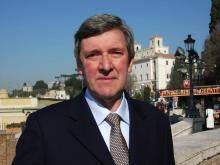A new department of the Roman Curia will come into existence on Sept. 1, called the Dicastery for the Laity, the Family and Life. The pontifical councils for the laity and for the family will cease to exist then, and the Pontifical Academy for Life will come under the umbrella of the new dicastery.
There was some surprise, however, that in the statute signed by Pope Francis on June 4, this new body is called a dicastery. The word, from Greek, is the generic title used to describe the nine congregations, 12 pontifical councils, three tribunals, three offices and four secretariats of the Roman Curia.
Its use in the statute raises a question: Is this dicastery a pontifical council or a congregation, which has a higher status? The evidence suggests the latter, since in the discussions preceding its establishment, including the extraordinary consistory of cardinals in February 2015, it was always referred to as a congregation. Moreover, the statute says it will be headed by a prefect, and only congregations and two secretariats are headed by a prefect.
Besides this, three other elements in the statute are worth noting. First, it envisages that the secretary “could be a layperson.” Hitherto, the secretary of the Pontifical Council for the Laity, as of every congregation, has always been a bishop.
Second, the dicastery will have three under secretaries, all laypeople (one for each of its sections: the laity, the family and life). While this is a step forward from the present situation, it is worth recalling that the two under secretaries of the Council for the Laity (the precursor to the P.C.L., set up by Pope Paul VI in 1966), were both laypeople: Mieczyslaw de Habicht (Poland) and Rosemary Goldie (Australia). She was one of only two women at the Second Vatican Council and the first to hold a position in the Roman Curia.
Third, the dicastery’s board members will include laymen and laywomen, both celibate and married, who are involved in different fields of activity and are from different parts of the world. Again, this is a return to the post-Vatican II period, when all members of the Council for the Laity were laypeople.
The establishment of the new dicastery is the culmination of a process of ever-growing attention to the role of the laity in the church that began at the Second Vatican Council. (The historical development is described well in From a Roman Window, by Rosemary Goldie, 1998.)
Pope Francis highlighted this historical development in his address to the last plenary assembly of the P.C.L. on June 17, before he spelled out his vision for the new dicastery.
The pope recalled that the P.C.L. came into existence “at the express will” of the Second Vatican Council, which called for a special secretariat to be “established at the Holy See for the service and promotion of the lay apostolate” to assist the hierarchy and laity. He said Vatican II emphasized that the laity’s involvement in the life of the church is “by reason of their baptism.”
Francis drew attention to the significant developments in the field of the laity over the past 50 years with the emergence of new movements and communities and new lay ministries, the growing role of women in the church and the creation of World Youth Day. But, he said, “much remains to be done in widening the horizons and taking up the new challenges that reality presents,” and this is the reason for the new dicastery.
The pope announced that the dicastery will take its direction from three documents: “The Lay Members of Christ's Faithful People,” St. John Paul II’s exhortation after the synod on the laity in 1987; “The Joy of the Gospel,” Francis’ programmatic document; and “The Joy of Love,” the pope’s post-synodal exhortation on the family.
He assigned it a dual task: to be “a church that goes forth, a laity that goes forth.” He concluded by saying:
We need laypeople who are formed well, animated by a clear and sincere faith, whose lives have been touched by a personal and merciful encounter with the love of Jesus Christ. We need laypeople who take risks, who soil their hands, who are not afraid of making mistakes, who move forward. We need laypeople with a vision of the future, who are not enclosed in the petty things of life. And we need laypeople with a taste of the experience of life, who dare to dream.








